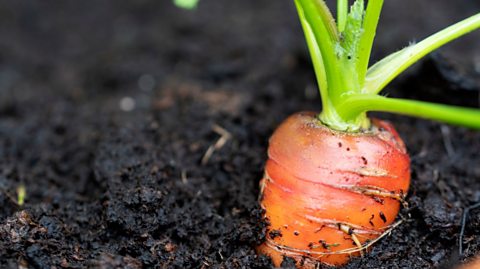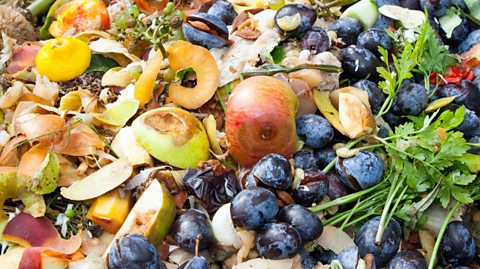The simple formula to cut your diet’s carbon footprint
To achieve the UK’s goal of being carbon neutral by 2050, we have to dramatically reduce our carbon footprint, including that of food and drink. Yet with factors from fertilisers to methane burped up by animals, food transportation to packaging, coming with a carbon price tag, it’s difficult to calculate the impact of our diet.

We Brits individually create on average 3 tonnes of carbon per year, or 8.2kg per day, from the food and drink we consume. So how do we reduce this? There are useful guidelines to follow when we shop, but to get a more accurate picture we need data.
Thankfully, one scientist has taken on the challenge of calculating the maths. Professor Mike Berners-Lee from the University of Lancaster has created UK ‚Äòcarbon equivalent‚Äô (C02e) data, outlining the total greenhouse gas cost, including methane, nitrous oxide and other gases, of everyday foods in the UK. On ≥…»ÀøÏ ÷ Two‚Äôs Horizon: Feast to Save the Planet, he reveals some surprising environmental facts about our favourite ingredients and has some advice about how to cut your carbon footprint.
Mike Berners-Lee’s UK carbon data charts
The charts add up the total cost of greenhouse gases. Berners-Lee has considered farming practices, the agricultural machinery required to harvest crops, methane burps, transport needed to get food and drink to the shops plus any other fuel requirements, processing and packaging. He intends the figures to be a rough guide, as all food supply chains are different and the knowledge is “far from certain”.
| FOOD | KG C02e PER KG PRODUCE |
|---|---|
| Oatmeal milk, unrefrigerated (from UK) | 0.2 |
| Apples (local) | 0.3 |
| Potatoes and root veg (UK grown) | 0.3 |
| Soya milk, unrefrigerated | 0.4 |
| Onions (UK grown) | 0.5 |
| Garlic (UK grown) | 0.5 |
| Apples (shipped from New Zealand | 0.6 |
| Lettuce (UK grown) | 0.6 |
| Almond milk, unrefrigerated (from California) | 0.6 |
| Bananas (shipped from Latin America | 0.7 |
| Broccoli (UK grown) | 0.7 |
| Squash (UK grown) | 0.7 |
| Cauliflower (UK grown) | 0.9 |
| Kale (UK grown) | 0.9 |
| Lemons (shipped from Spain) | 0.9 |
| Grapes (driven from Spain) | 1.1 |
| Asparagus (UK grown) | 1.1 |
| Bread (UK produced) | 1.1 |
| Melons (shipped from Spain) | 1.2 |
| Broccoli (driven from Spain, Italy or France) | 1.2 |
| Spinach (UK grown) | 1.2 |
| Cucumber (UK produced, in season) | 1.3 |
| Standard tomatoes (UK grown, in season) | 1.3 |
| Oats (Scotland produced) | 1.3 |
| Sweetcorn (driven from Spain) | 1.4 |
| Flour (UK produced) | 1.5 |
| Pasta (UK produced) | 1.5 |
| Tofu | 1.5 |
| Avocado (shipped from South Africa, Peru or Chile) | 1.6 |
| Quinoa (shipped from Peru) | 1.6 |
| Cucumber (driven from Spain) | 1.7 |
| Strawberries (Scotland produced) | 1.7 |
| Strawberries (driven from Spain) | 1.8 |
| Avocados (driven from Spain) | 1.8 |
| Lettuce (driven from Spain) | 1.8 |
| Strawberries (driven from Spain) | 1.8 |
| Cow's milk (British produced) | 1.9 |
| Cocoa powder (shipped from Africa) | 1.9 |
| Avocados (driven from Spain) | 2.0 |
| Pasta (driven from Italy) | 2.0 |
| Sardines (caught in UK) | 2.0 |
| Herbs (UK grown) | 2.1 |
| Mackerel (caught in UK) | 2.1 |
| Sugar | 2.1 |
| Peas, lentils, chickpeas, beans (shipped from America) | 2.1 |
| Margarine (British) | 2.1 |
| Nuts and seeds | 2.3 |
| Jam, honey or marmalade (local) | 2.3 |
| Yoghurt (British) | 2.4 |
| Chocolate (processed Europe, driven) | 2.4 |
| Tomatoes (driven from Spain) | 2.5 |
| Berries (frozen) | 2.6 |
| Dried fruits | 2.9 |
| Peppers (hothoused, driven from Netherlands) | 3.0 |
| Rice (shipped from Asia) | 3.8 |
| Whole chicken (UK produced) | 3.8 |
| Prawns and shrimps (caught in UK) | 3.8 |
| Quorn | 4.0 |
| Mushrooms (UK produced | 4.1 |
| Scottish salmon (fresh, farmed) | 4.1 |
| Cod (caught in UK) | 4.1 |
| Cod (shipped from Iceland) | 4.4 |
| Baby plum tomatoes (hothoused in UK) | 4.6 |
| Tinned tuna | 5.3 |
| Cream (British) | 5.9 |
| Whole chicken (global average) | 8.1 |
| Butter (British) | 9.8 |
| Bacon (UK produced) | 10 |
| Mozzarella (UK produced) | 10.1 |
| Mozzarella (driven from Italy | 10.3 |
| Cheddar (UK produced) | 11.8 |
| Grapes (flown from South Africa) | 18.5 |
| Asparagus (flown from Peru) | 18.5 |
| Eggs (British) | 19.1 |
| Parmesan (driven from Italy) | 19.1 |
| Lamb (UK produced) | 21 |
| Tuna (flown from Seychelles) | 22 |
| Tiger prawns (farmed Thailand) | 25 |
| Beef (UK produced) | 25 |
| Beef steak (imported from deforested land) | 83.3 |
Guidelines to cut the carbon footprint of your food shop
1. Know when food is in season
Many vegetables and fruits have a low carbon footprint, but check where they are grown and packaged before buying. Seasonal produce tends to create less greenhouse gas because it’s grown without artificial heat, and if it’s homegrown it doesn’t have to be shipped or – worse – flown in.
Root veg grown in the UK are mostly in season for many months and store well. Locally grown potatoes create 106g C02e per 200g when boiled gently with the lid on. Towards the other end of the scale, hothouse-grown tomatoes are very high in carbon, with as much as 2.28kg C02e per 100g for organic vine cherry tomatoes grown in this way in the UK, compared with 130g C02e for large salad tomatoes grown locally in season without the need for hothousing.
Highly perishable veg and fruit, such as asparagus and berries, may be flown in when out of season, but you can buy UK produce when it’s in season and freeze it. Compare strawberries bought in season locally at 490g C02e per 250g punnet with those grown locally in a hothouse out of season, or flown in from South Africa, at a whopping 3.65kg C02e for the same weight.
Farming methods are important too. Synthetic fertilisers sprayed on fields contain chemicals such as ammonium and nitrogen, which help the crops grow but contribute significantly to global CO2 emissions. Without more information on labels about how food is produced, it is difficult for consumers to identify low-carbon options.

2. Cut back on meat and dairy and choose it carefully
A major 2019 report on land use and climate change says the West’s high consumption of meat and dairy produce is contributing to global warming. A document prepared by scientists for the UN’s says that if land is used differently, it can reduce the amount of carbon produced by our food.
The average farm animal converts 10 percent of the calories it eats into meat and dairy, according to Berners-Lee. If animals are fed crops that could be eaten directly by humans, this is much less efficient than eating the plants ourselves.
But imported beef, especially from somewhere like Brazil, where cattle ranching is the main driver of deforestation both for keeping cattle and for producing soya to feed them, can have about three times the carbon footprint of British beef. Most beef sold in the UK is farmed here (this information is usually on the packaging), and grass-feeding cattle is common in Britain, although it is often supplemented in the winter. Much British grazing land is not suitable for growing crops. “You’re either going to let that ground go fallow and do nothing with it or you’re going to use it to produce a food that is highly nutritious, healthy and tastes delicious”, says food writer Matthew Fort.
Patrick Holden, Founding Director of the Sustainable Food Trust, calls for “increased consumption of grass-fed or mainly grass-fed beef and lamb. Unless we purchase these products, it will be impossible for our farmers to introduce fertility-building grasslands into their crop rotations, which will be essential to rebuild soil carbon stocks.”
Bacon, pork and chicken have a lower carbon footprint than beef, according to Berners-Lee.
Weight-for-weight, “the carbon footprint of cheese isn’t that much lower than of beef and lamb”, mathematician Dr Hannah Fry says. But we commonly eat much less cheese in a portion than we do meat. Not all cheeses have the same carbon footprint: “softer cheese tends to use less milk”, Dr Hannah continues. Using cheese sparingly, for instance by grating Parmesan on a microplane, will help limit its impact on your carbon footprint.
3. Eat everything you buy
Each year as a nation we throw away 4.5 million tonnes of food from our own homes, a whopping 70 percent of the total food that is wasted in the UK, according to charity . This has both the carbon footprint of producing the food and disposing of it. Check your fridge and cupboards before writing a shopping list, and only buy what you need. If you can’t eat it, give it to someone else. It’s also a good idea to eat smaller portions of high-carbon ingredients, bulking out meat, fish and dairy on your plate with vegetables and pulses.

4. Buy less packaging
Producing plastic emits greenhouse gases, forming it into packaging produces more, and disposing of it produces more still. “On the current course, emissions from plastics will reach 17 percent of the global carbon budget by 2050”, according to a by University of California – Santa Barbara. Other packaging also produces carbon. If possible, buy foods loose and use your own bags.
5. Use low-carbon cooking methods
Saucepans are less efficient than kettles, according to Berners-Lee, and we should only boil water in a saucepan if we are putting food into the pan when the water is cold so it cooks in the warming water. If you don’t put a lid on your saucepan, he says you’ll waste 20 percent of the energy. A couple of other tricks to minimise waste are to avoid boiling more water than you need and, when boiling veg, boil gently and cut it into small pieces. Make the most of energy-efficient cookers, such as a microwave or pressure cooker, and once you’ve heated up the oven fill it up to make full use of the energy.

What to look out for
The more we know about how our food got to us, the more informed our decisions will be. Is it a low-carbon product? Does the producer practice low-carbon methods? If it is imported, where from and how in tune is that country with low-carbon farming? Was it flown in? Is it in season in its country of origin? Is it hot housed or grow in natural sunlight? All these will have an impact on its carbon footprint.
Carbon isn’t the only way food affects the environment, though. Other factors to consider include the impact of loss of habitat, including conversion of rainforest to farmland, on biodiversity. There is also the problem of monocropping: 75 percent of the world’s food comes from just 12 crops and 5 animal species, affecting the soil’s ability to soak up carbon from the atmosphere and the insects that thrive.
Online shopping can connect you with fresh food producers who are happy to tell you where their food comes from and how it’s grown. Box schemes will challenge you to diversify your diet with seasonal vegetables, and many shorten the supply chain significantly, connecting you directly with British farmers.
All the C02e data in this article is from How Bad Are Bananas?: The Carbon Footprint of Everything by Mike Berners-Lee, published by Profile Books. It is based on Small World's Food carbon models.
Horizon: Feast to Save the Planet is on ≥…»ÀøÏ ÷ iPlayer.